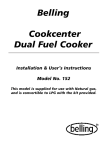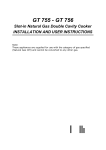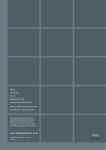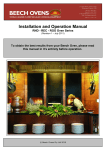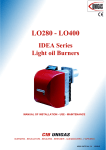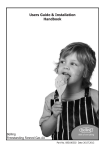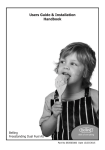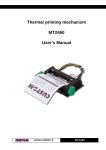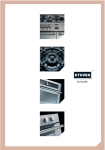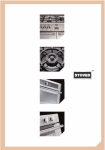Download Belling 152A Installation guide
Transcript
08 27095 00- 152A CC 14/6/04 10:59 am Page 1 Cookcenter Dual Fuel Cooker Electric ovens & Gas hob Users & Installation Guide Model number 152A This model is supplied for use with Natural gas, and is convertible to LPG (Propane) with the kit supplied. 08 27095 00- 152A CC 14/6/04 10:59 am Page 2 08 27095 00- 152A CC 14/6/04 10:59 am Page 3 CONTENTS Introduction . . . . . . . . . . . . . . . . . . . . . . . . . . . . . . . . . . . . . . . . . . 2 Installation instructions . . . . . . . . . . . . . . . . . . . . . . . . . . . . . . . . . . 3 For your safety - always . . . . . . . . . . . . . . . . . . . . . . . . . . . . . . . 11 For your safety - never . . . . . . . . . . . . . . . . . . . . . . . . . . . . . . . . . 12 Know your cooker . . . . . . . . . . . . . . . . . . . . . . . . . . . . . . . . . . . . 13 Know your timer . . . . . . . . . . . . . . . . . . . . . . . . . . . . . . . . . . . . . 15 Using your electronic timer . . . . . . . . . . . . . . . . . . . . . . . . . . . . . . 16 Hob . . . . . . . . . . . . . . . . . . . . . . . . . . . . . . . . . . . . . . . . . . . . . . . 23 Griddle . . . . . . . . . . . . . . . . . . . . . . . . . . . . . . . . . . . . . . . . . . . . . 24 Warming zone . . . . . . . . . . . . . . . . . . . . . . . . . . . . . . . . . . . . . . . 25 Oven temperature chart . . . . . . . . . . . . . . . . . . . . . . . . . . . . . . . . 26 Grilling . . . . . . . . . . . . . . . . . . . . . . . . . . . . . . . . . . . . . . . . . . . . . 27 Fan Oven - Cookery notes & charts . . . . . . . . . . . . . . . . . . . . . . . 28 Conventional oven - Cookery notes & charts . . . . . . . . . . . . . . . . 32 Slow cook / Warming oven . . . . . . . . . . . . . . . . . . . . . . . . . . . . . 37 Care & Cleaning . . . . . . . . . . . . . . . . . . . . . . . . . . . . . . . . . . . . . . 39 Is there something wrong? - Troubleshooting . . . . . . . . . . . . . . . . 39 Service information. . . . . . . . . . . . . . . . . . . . . . . . . . . . . . . . . . . . 43 1 08 27095 00- 152A CC 14/6/04 10:59 am Page 4 INTRODUCTION Thank you for buying this Belling appliance. We hope that you find it to be a stylish and attractive addition to your kitchen, and enjoy cooking with it. Warning! For your own safety, please make sure these instructions on installation, use and maintenance are followed. We advise that you keep these instructions in a safe place for future reference. If you sell, or transfer ownership of this appliance, please pass on these instructions to the new owner. Your Belling Cooker There are the following features: l a fanned oven, l a conventional oven, l a slow cook/warming oven, l a separate grill, Unpacking your appliance l a seven burner gas hob with a warming area Please make sure that you have removed all packaging, wrapping, labels and stickers from the appliance before use. l a removable griddle plate. There is also a clock /timer with a minute minder and automatic oven switch on and off. Getting help Should you need any help installing, operating or cooking with this appliance, please check these instructions thoroughly to make sure you have not missed anything. If you still require advice or assistance please contact: When making a call for advice please quote the cookers model number and serial number. These numbers can be found on the left hand side of the oven frame. These numbers can be written in the box provided on this page. Model Number Serial Number 2 08 27095 00- 152A CC 14/6/04 10:59 am Page 5 INSTALLATION INSTRUCTIONS Gas Safety (Installation & Use) Regulations. mum distance of 1085mm between the cupboard units of hotplate height. This appliance must be installed by an authorised person in accordance with the manufacturers installation instructions, local gas fitting regulations, the AGA Gas Installations, the Australian Gas Installation Code AG601 /AS5601 and any other relevant statutory regulations. Particular attention should be given to relevant requirements regarding ventilation. The wall behind the cooker between the hotplate and 450mm above and across the width of the cooker, must be an incombustible material such as ceramic wall tiles. Follow the diagrams provided for guidance on fitting. Take note of all dimensions. Where this appliance is installed in Marine craft or caravans - it shall not be used as a space heater. Space for fixing The cooker can be close fitted below hotplate level. This requires a mini- 3 08 27095 00- 152A CC 14/6/04 10:59 am Page 6 INSTALLATION INSTRUCTIONS Electrical connection: 6mm2 cable Technical Data 230 - 240 v a.c. 50Hz Dimensions Height 900 - 915mm Total heat Input (Gas): Width 1090mm Natural gas 59.40MJ/h Depth LPG gas (propane) 55.30 MJ/h 600mm (excluding handles) Total heat Input (electric): General 7.35 - 8.00 kW Gas connection: RP1/2 (1/2 Fan oven bottom left: BSP Female) Burner pressure: 2.30 - 2.50kW Natural gas - 1.0kPa Grill top left: 2.38 - 2.60kW LPG gas (propane) 2.75 kPa Conventional oven (top right): 2.20 - 2.40kW Pressure test point: Slow cook / Warming oven: Gas regulator or middle rear hob burner. (see “Checking Burner Pressure”) 0.20 - 0.22kW Warming zone: 0.23 - 0.25kW Gas rate adjustment: none Aeration adjustment: none Natural Gas Burner Heat Input Injector LPG - Propane Heat Input Injector Front Middle (Ultra Rapid)/ Wok. 12.60MJ/h 1.65mm 12.60MJ/h 0.95mm Rear Left (Rapid) 11.52MJ/h 1.55mm 10.80MJ/h 0.87mm Front Left / Rear Middle (Semi-rapid) 7.74MJ/h 1.25mm 6.66MJ/h 0.69mm Front & Rear Right (Auxiliary) 4.14MJ/h 0.90mm 3.89MJ/h 0.53mm 4 08 27095 00- 152A CC 14/6/04 10:59 am Page 7 INSTALLATION INSTRUCTIONS Unpacking the cooker l The front feet can simply be screwed in or out to lower or raise the front of the cooker. Unpack the components from inside the grill and the oven. Please make sure that you remove everything from inside the cavities. Caution: Check that the following are present: Some soft floor coverings may get damaged if the cooker is not moved carefully. l Grill pan and grid l Pansupports (3) l Main oven shelves (4) l Meat pan l Literature l Griddle Levelling Two rear wheels and two front feet are fitted which can be adjusted up or down to set the height (900mm 915mm) and level the cooker. l The rear wheels can be raised or lowered from the back of cooker by adjusting the levelling screws ‘A’ in the plinth. 5 08 27095 00- 152A CC 14/6/04 10:59 am Page 8 INSTALLATION INSTRUCTIONS Stability bracket l Position the stability bracket in accordance with the diagram (Fig 1). The cooker must be fitted a stability device firmly secured to the fabric of the building. The back of the cooker has a slot for attaching the stability bracket, which can be obtained from your cooker supplier. The leaflet included with the bracket should be read in conjunction with the following instructions: l Measure the height from floor level to the bottom of the slot in the back of the cooker. l Add 3mm to the dimension and assemble the stability bracket to that height (i.e. from the floor level to the underside of the top member) l Push the cooker to its intended position l Draw pencil lines on the floor in line with the front and left side of the plinth. l Remove the cooker. 6 08 27095 00- 152A CC 14/6/04 10:59 am Page 9 CONNECTING TO THE GAS SUPPLY The cooker is designed to match the depth of standard 600mm worktops. An adaptor backplate should, therefore, be fitted within the 400 x 250mm shaded area shown to allow the cooker to be pushed fully to the wall. Connection to the cooker should be made using an AGA certified hose assembly and regulator (Natural Gas only). Note: Maximum length of hose = 900mm. The temperature rise of areas at the rear of the cooker that are likely to come into contact with with the flexible hose do not exceed 70˙C. If a forward facing backplate is used, it must be chased to the wall. Means of isolation shall be provided at the shut off point by either an approved quick connect device or a a Type 1 manual shut off valve. The outlet of the quick connect device shall be at, or below, the horizontal position 7 08 27095 00- 152A CC 14/6/04 10:59 am Page 10 CONNECTING TO THE GAS SUPPLY A restraining chain or wire of adequate strength is to be fixed to the appliance and the wall within 50mm of each connection point. The length of the chain or wire is not to exceed 80% of the length of the hose assembly. The restraining chain or wire is to prevent stress being imparted onto the hose assembly when the cooker is moved out of its normal operating position. After installation check for soundness. The burner pressure is tested at the pressure regulator or rear middle hob burner. With reference to the users instructions: l Check that the hotplate burners ignite correctly and burn with a steady flame. l Check for a steady flame at the lowest setting (small flame symbol). Finally, instruct the user on the operation of the cooker and give them this book for reference. 8 08 27095 00- 152A CC 14/6/04 11:00 am Page 11 CHECKING BURNER PRESSURE Burner pressure of the appliance can be checked at the gas regulator (Natural Gas) or middle rear burner (Semi Rapid) on the appliance hob. To check the burner pressure of the appliance at the middle rear hob burner, the adaptor (illustrated) will be required. flat ended screw driver as follows: Clockwise adjustment to lower the flame. Anticlockwise to increase the flame. A torch may assist in this operation. The bypass screw adjustment Remove the burner jet from the middle rear burner (Semi Rapid) and screw in the adaptor. Connect the test equipment, and ignite the rear left burner (Rapid) and operate at its maximum gas rate. Pressure should be be as stated on the data badge (adjust the pressure if required) Removed the adaptor and replace the jet in the middle rear burner (Semi Rapid). Bypass Screw adjustment The low rate setting of the individual gas burners are preset for Natural Gas and should not require adjustment. However, if adjustment is required then the bypass screw, situated on the gas tap and located through the aperture in the control panel, can be adjusted with the aid of a thin bladed 9 08 27095 00- 152A CC 14/6/04 11:00 am Page 12 CONNECTING TO THE ELECTRICAL SUPPLY Connecting The Cooker Allow sufficient cable for the cooker to be pulled out for cleaning, but do not let it hang closer than 25mm (1”) to the floor. The cable can be looped if necessary, but make sure that it is not kinked or trapped when the cooker is in position. For your own safety we recommended that your cooker be installed by a competent person. The cooker should be installed in accordance with AS/NZS 3000: 2000. Before Cooking Warning! This cooker must be earthed. Before you cook for the first time, we recommend that you switch on each element in turn to burn off any odours remaining from manufacture. The cooker must be connected to the correct electrical supply as stated on the rating plate, through a suitable cooker control unit incorporating a double pole switch having a contact separation of at least 3mm in all poles, adjacent to(but not above) the cooker. We recommend the cooker circuit be rated to 45 amps with a minimum of 30 amps. We recommend that 6m2 PVC insulated twin and earth cable is used to connect the cooker to the cooker control unit, the minimum size of cable that can be used is 6mm2 twin and earth the maximum size is 10mm2 twin and earth. Important For access to the mains terminal block, for supply cable connection, it is necessary to remove the mains terminal cover, located at the lower right hand side of the rear panel. No part of the appliance will operate unless the main control unit is switched ON. 10 08 27095 00- 152A CC 14/6/04 11:00 am Page 13 FOR YOUR SAFETY Please read the following pages before using your cooker cleaning or changing a light. 4 Always refer servicing to registered service engineers. 4 Always make sure you understand the controls before using the cooker. 4 Always ensure that the griddle is fitted correctly to the pansupports and that the fingers are located within the slots of the griddle feet. 4 Always check the controls of the cooker are switched off after use. 4 Always stand back when opening the oven doors to allow heat to disperse. 4 Always remove the griddle handle while cooking. 4 Always use dry, good quality oven gloves when removing items from the oven. 4 Always take care when fitting the griddle handle not to touch any of the hot surfaces of the griddle or the cooker. 4 Always take care when removing items from the top oven/grill when the main oven is on, as the contents might be hot. 4 Always remove any spillage from the surface of the lid before opening it. 4 Always allow the hob to cool before closing the lid. 4 Always keep the oven and grill doors closed when the cooker is not in use. 4 Always during use, the oven becomes hot. Care should be taken to avoid touching heating elements inside the oven. 4 Always place pans centrally over the hotplate burners and position them so they cannot be accidentally knocked, caught or become heated by other burners. 4 Always keep the cooker clean, as a build up of grease or fat from cooking can cause a fire. 4 Always allow the cooker to cool before cleaning. 4 Always follow the basic practices of food handling and hygiene to prevent the possibility of bacterial growths. 4 Always keep ventilation slots clear of obstructions. 4 Always turn of the electricity before 11 08 27095 00- 152A CC 14/6/04 11:00 am Page 14 FOR YOUR SAFETY 6 Never leave children unattended where the cooker is installed as all surfaces will get hot during and after use. 6 Never use plastic items in or on the cooker. 6 Never leave the handles on the griddle while cooking. 6 Never allow anyone to sit or stand on any part of the appliance. 6 Never use steam cleaners on the cooker. 6 Never store items that children may attempt to reach above the appliance. 6 Never spray aerosols in the vicinity of the cooker while it is in operation. 6 Never fill chip pans more than 1/3 full with oil or fat, or use a lid. D O NOT LEAVE PANS UNATTENDED WHILE COOKING. 6 Never store flammable materials in the storage drawer of the cooker. 6 Never use propriety spillage wells on the hotplate, eg. foil spillage bowls. 6 Never heat up unopened food containers as pressure can build up causing the container to burst. 6 Never store chemicals/ food stuffs, or pressurised containers in or on the cooker, or in cabinets immediately above or next to the cooker. 6 Never place flammable items or plastics on or near the hotplate. 6 Never use the cooker as a room heater. 6 Never dry clothes or place other items over or near the hotplate or the oven/grill doors eg. tea towels or oven gloves. 6 Never wear garments with long flowing sleeves while cooking. 6 Never leave items that could catch fire near the burners of the flue. 6 Never leave burners lit while not in use. 12 08 27095 00- 152A CC 14/6/04 11:00 am Page 15 KNOW YOUR COOKER The use of a gas appliance results in the production of heat and moisture in the room in which it is installed. Ensure that the kitchen is well ventilated; keep natural ventilation holes open or install a mechanical ventilation device (mechanical extractor hood). Prolonged intensive use of the appliance may call for additional ventilation, for example opening of a window or more effective ventilation i.e. increasing the level of mechanical ventilation where present. 13 08 27095 00- 152A CC 14/6/04 11:00 am Page 16 CONTROL PANEL Operating controls when the grill is in use. Oven light The oven light will illuminate when the control panel is operated. The light will remain on during the cooking period. In common with all cookers having controls sited above the grill compartment, care must be taken when setting the controls, due to the hot air being expelled from the grill compartment. Cooling fan A gentle flow of air will be blown below the control panel when the grill / oven controls are in use. 14 08 27095 00- 152A CC 14/6/04 11:00 am Page 17 KNOW YOUR TIMER The oven timer offers you the following features: by the long, slow method, so that the delay period is kept to a minimum. 1. Time of day 2. Automatic cooking 3. Minute minder l On warm days, to prevent the growth of harmful bacteria in certain foods (i.e. poultry, joints etc.) the delay period should be kept to a minimum. l Wine or beer may ferment and cream may curdle during the delay period, so it is best to add these ingredients just before serving. Automatic cooking The main fan oven can be controlled automatically. l Foods which discolour should be protected by coating in fat or tossing in water to which lemon juice has been added prior to placing in the oven. Guidance on automatic cooking l Select food which will take the same length of time to cook, and require the same temperature. l Dishes containing liquid should not be filled too full to prevent boiling over. l Set the oven timer so that food will have finished cooking, or be about to finish cooking on your return to the oven. This will ensure that the food is hot and will not require re heating. l Foods should be well sealed (but not airtight) in a container to prevent the loss of liquid during cooking. Aluminium foil gives a good seal. l Food should be as cold as possible when it goes into the oven, ideally straight from the refrigerator. Frozen meat and poultry should be thawed thoroughly before it is put into the oven. l Ensure that the food is cooked through before serving. l We advise that warm food is never placed in the oven for automatic cooking. Stews prepared by frying the meat and vegetables should be cooked as soon as possible. l We advise that dishes containing left over meat or poultry e.g. Shepards Pie should not be cooked automatically, if there is a delay period. l Stews and joints should be cooked 15 08 27095 00- 152A CC 14/6/04 11:00 am Page 18 ELECTRONIC TIMER OPERATION Clockface The cookpot symbol will light up either:- The timer incorporates a 24 hour clock. l When the timer is in manual mode. l During the actual Cook Period. A U T O Ensure that the clock is set to the correct time before using your cooker. The ‘AUTO’ symbol will light up :l When the timer is first turned on it will flash. It will go out when a time of day is set or when the timer is set to manual. Symbols A bell symbol will light up when you select a Minute Minder Period, and will remain lit for the period set. l The ‘AUTO’ symbol will flash at the end of an Auto Cooking programme to indicate that the programme has finished. At the end of the Minute Minder Period, the timer will emit an audible tone and the bell symbol will disappear A U T O When the ‘AUTO’ symbol is flashing, to return to the oven to Manual operation, turn all the oven controls off, ensure the correct time of day is set and press the ‘MANUAL’ button - the ‘AUTO’ symbol will go out. 16 08 27095 00- 152A CC 14/6/04 11:00 am Page 19 ELECTRONIC TIMER OPERATION Timer Function Buttons programme. You will need to set the oven temperature controls to the required temperature when you set the oven. The oven will only operate during the pre selected time when set for automatic - it will not turn on earlier. Minute minder button: Here you can set a time period of up to 23 hours and 59 minutes. When the timer reaches zero, an audible tone will sound. Example: If you set 20 minutes, the tone will sound 20 minutes later. Manual Button: Needs to be pressed to cancel an automatic programme and return the oven to the manual setting. Auto Cooking Programme. Cook Period Button: Cook Period is the actual length of time for which the timer will switch the ovens on, as part of the ‘Auto Cooking’ programme. Plus and Minus Buttons: These are used for adding, or reducing time on the clock. Also for adding or reducing time to Auto Cooking programmes, and the Minute Minder function. (e.g. if you set two hours, the food will be cooked for 2 hours) End Time Button: The time of day you would like the Auto Cooking programme to end. (e.g. If you set a cook period of 2 hours and an end time of 11.00. The timers will set the oven to come on at 9.00 and turn off at 11.00. You will hear a tone to signal the end of the 17 08 27095 00- 152A CC 14/6/04 11:00 am Page 20 ELECTRONIC TIMER OPERATION Setting the time of day button. Shown in black on the diagram below. Make sure all the oven controls are turned off. l With the Minute Minder button held in, use the ‘+’ and ‘-’ buttons to set the required duration. Shown in grey on the diagram below l Check the electricity supply to the cooker is turned of. l When switched on the display will show 00.00 and the ‘AUTO’ symbol flashing intermittently. l Release all the buttons and the timer display will revert back to the time of day. The bell symbol will remain lit to signify that a Minute Minder period has been set. l Press and hold the Cook Period and the End Time buttons together. Shown in black on the diagram below. l Use the ‘+’ and ‘-’ buttons to selected the time of day. Shown in grey on the diagram below. l Release all the buttons simultaneously. l The time of day is now set. At the end of the set time an audible tone will be heard, and the bell symbol will disappear. A U T O To cancel the Minute Minder, and stop the audible tone press the Minute Minder button. To change the time of day repeat steps 4, 5 & 6 above. Notes: l The remaining time can be checked when the Minute Minder has been set, by pressing the Minute Minder button. Note: You cannot set the time of day if the oven is set for an Auto Cooking Programme. l The Minute Minder function can be cancelled by holding the Minute Minder button down, and pressing the ‘-’ button until the timer has counted back to 0.00 Setting the Minute Minder l Ensure the time of day is set correctly. l Press and hold the Minute Minder 18 08 27095 00- 152A CC 14/6/04 11:00 am Page 21 ELECTRONIC TIMER FUNCTION Automatic Cooking Programmes l Release the buttons and the timer display will revert to the time of day with the ‘AUTO’ and cook pot symbols lit. There are two automatic cooking programmes that can be selected using your timer: l Press and hold the End Time button. The display will show the earliest end time possible for the cook time you have set. The ‘AUTO’ and cook pot symbols will be lit. l To set the timer to switch the oven on and off automatically. l To set the timer to switch on immediately and off automatically after a set Cook Time. A U T O To set the timer to switch the oven on and off automatically. This allows you to chose a specific time for a chosen period before the oven switches off automatically. l With the End Time button still held in, use the ‘+’ and ‘-’ buttons to chose the time you wish the oven to switch off. This is the ‘End Time’. l Check that the correct time of day is set. If it is not, please set the clock following the instructions earlier in the book. l Release all the timer buttons and the display will revert back to the time of day. l Place the food on the correct shelf position and close the door. l The ‘AUTO’ symbol will remain lit to signify that an Auto Cooking Programme has been set. The cook pot symbol will go out. l Press and hold the Cook Time button, the display will read 0.00 with the cook pot symbol lit. l Still holding in the Cook Time button, set the required cooking period using the ‘+’ and ‘-’ buttons. A U T O 19 08 27095 00- 152A CC 14/6/04 11:00 am Page 22 ELECTRONIC TIMER FUNCTION l Turn the oven controls to the required temperature, and select ant necessary functions. l At the end of the Automatic Cook Period the ‘AUTO’ symbol will flash and an intermittent bleeping sound will be heard. l The tone will continue until it is cancelled. The ‘AUTO’ symbol will continue to flash until the timer is returned to Manual operation. l Press the Manual button and the audible tone will stop, the ovens will also return to the Manual setting. When you have finished with the Automatic Cooking, please make sure that all the oven controls are switched to the off position. 20 08 27095 00- 152A CC 14/6/04 11:00 am Page 23 ELECTRONIC TIMER OPERATION Automatic Cooking Programmes. time of day with the ‘AUTO’ symbol lit and the cook pot remaining lit. A U T O To set the timer to switch on immediately and off automatically after a set cook period. l Check that the correct time of day is set. l Place the food onto the correct shelf position in the oven and close the door. l At the end of the Cook Period the ‘AUTO’ symbol will flash and an intermittent audible tone will be heard. The audible tone will be heard until cancelled and the ‘AUTO’ symbol will continue to flash until the timer is returned to Manual. l Turn the oven controls to the required temperature, and if necessary select the appropriate function. l Press and hold the Cook Period button, the display will read 0.00 and the cook pot symbol will light up. l Press the Manual button to cancel the tone and return the oven to Manual. l With the Cook Period button held down set the required Cook Period using the ‘+’ and ‘-’ buttons. When you have finished with the Automatic Cooking, please make sure all of the oven controls are switched to the off position. Notes: l When using either Automatic Cooking programme, the Cook Period can be checked at any time by pressing the Cook Period button. Please note: the Cook Period is the length of time the food requires cooking. l The End Time can also be checked by pressing the End Time button at any point during the cooking. l Release all buttons. l The timer display will revert to the 21 08 27095 00- 152A CC 14/6/04 11:00 am Page 24 ELECTRONIC TIMER OPERATION Cancelling an Automatic Cooking programme. l If a mistake is made while programming, or you need to change the information you’ve entered, you can clear the programmer this way: You can cancel the Automatic Cook Period at any time. You do not have to let it finish. Press and release the Manual button. To cancel : l Turn the oven controls to the off position. Start re entering the information again. l Press the Manual button to return the ovens to Manual operation. The ‘AUTO’ symbol will go out. Pressing Manual cancels all the information previously entered. l If at any time the display shows three zero’s flashing (0.00) and ‘AUTO’, it is likely that the power supply has been interrupted. Reset the timer to the correct time of day. If you have been cooking, or set an Auto Cook programme, it may not have cooked, so please check that any food is thoroughly heated before serving. Notes on timer operation: l When cooking automatically, the Cook Period can be checked at any time by pressing the Cook Period button. l When cooking automatically the End Time can be checked at any time by pressing the End Time button. l To set each function always press and hold the required function button and at the same time press the ‘+’ and ‘-’ buttons. l Having set a Cook Period and End Time an electronic device stores the information. The device within the timer will switch the oven on and off at the required times. 22 08 27095 00- 152A CC 14/6/04 11:00 am Page 25 HOB Your Hob Safety for deep fat frying The hob lid is fitted with a safety device which cuts off the gas supply to the hotplate burners unless the lid is fully opened and the manual lever to the right of the hotplate vent is lifted to the upright position Do not use the safety device as a means to control the hotplate burners. 6 Never fill chip pans more than one third full of fat or oil. 6 Never leave fat or oil unattended during the heating or cooling period. 6 Never heat or fry with the lid on. 4 Always dry food thoroughly before frying and lower it slowly into the hot oil or fat. Frozen foods in particular cause frothing and spitting if added too quickly. The hob has 1 x ultra rapid wok burner, 2 x rapid burners, 2 x semi-rapid burners and 2 x auxiliary burners which will accommodate pans between 100mm (4”) and 230mm (9”). 4 Always keep the outside of the pan clean and free from streaks of oil and fat. All pans should be placed centrally over the burners. How to deal with a fat fire To use the hob l Turn off the hotplate burners. Check the electricity supply is switched on. l Smother the flames with a fire blanket or damp cloth. Do not use water or a fire extinguisher as the force of it may spread the burning fat or oil over the edge of the pan. l Do not move the pan. l Push in and turn the control knob of your chosen burner anti-clockwise to the large flame symbol. l Leave the pan for at least 60 minutes before moving it. l Turn the knob anti-clockwise to the desired setting. Only turn the knob between the large flame symbol and the small flame symbol for adjusting the setting. Re-lighting the burner In the event of the burner flames being extinguished accidentally, turn off the burner control and do not attempt to re ignite the burner for at least one minute. l To turn off, turn the control knob fully clockwise. Do not use mis shapen pans which may be unstable. If the surface of the glass warming area becomes cracked, switch off the cooker to avoid electric shocks. Call for a engineer and do not use. Do not use round base woks directly on the pan supports. Do not use the glass lid as a work surface. 23 08 27095 00- 152A CC 14/6/04 11:00 am Page 26 GRIDDLE Important Note Use of the griddle The griddle must only be used over the two simmer/auxiliary burners. l Position the griddle at the top of the pan support, with the locating legs on the underside engaged on the pan support fingers, above the simmer burners. A non stick griddle is supplied for use over the two simmer/auxiliary burners on the right hand side of the hob. The griddle must be positioned on the top of the pan support, with the legs on the underside engaged on the pan support fingers. l Push in and turn the control knob(s) anti-clockwise to the large flame symbol. Press the ignition button until the burner(s) light. The griddle must not be placed directly on top of the simmer burners. l The controls should then be set at the small flame setting as a gentle heat is all that is required for griddling. To protect the non stick coating never use metal cooking utensils as they may scratch. Wooden or heat resistant plastic utensils may be used. Under no circumstances must the griddle be used over any other hot plate. l Cook the food for the required, which will depend on the food being cooked. l To turn off, turn the control knob(s) fully clockwise to the position ‘O’. l Do not remove the griddle from the cooker whilst hot. The griddle may be used with either or both of the simmer burners on, depending on the food being cooked. The griddle can be positioned with the ridged portion at the front or at the rear. l Allow the griddle to cool before removing and cleaning. l Clean the griddle with warm soapy water. Do not put into a dishwasher. Caution: Do not refit the griddle plate to the hob if the glass lid is to be lowered. 24 08 27095 00- 152A CC 14/6/04 11:00 am Page 27 WARMING ZONE To the rear of the wok burner is a warming zone which can be used for a wide range of non cooking tasks associated with the preparation of meals. It provides a gentle heat surface and can achieve a surface temperature of 120˙C and is specially designed for keeping coffee hot as well as gravy, custard and other sauces. The warming zone warning neon illuminates on the control panel if the warming zone control is operated. To warm plates on the warming zone, simply place your plates on the warming zone and turn the control knob to the on position. 25 08 27095 00- 152A CC 14/6/04 11:00 am Page 28 APPROXIMATE OVEN TEMPERATURES GAS MARK CONVENTIONAL OVEN ˙F ˙C FAN OVEN (It is not always necessary to pre heat oven) ˙C 1/2 250 120 100 1 275 140 120 2 300 150 130 3 325 160 140 4 350 180 160 5 375 190 170 6 400 200 180 7 425 220 200 8 450 230 210 9 475 240 220 26 08 27095 00- 152A CC 14/6/04 11:00 am Page 29 GRILLING NEVER allow your children near the appliance when the grill is in use as the surfaces get extremely hot. ting after the initial sealing on both sides at 5. The thicker the food the lower the setting should be set. After use, always return controls to their off position. Grilling should never be undertaken with the grill door closed. Note: Do not line the grill pan with aluminium foil. Utensils stored in the grill compartment will get hot when the fan oven is in use. Care should be taken when removing them. The grill control is designed to provide to provide variable heat control on either left and right grill elements together or left hand element only, depending on which direction the control knob is rotated. With the control knob rotated clockwise both elements will come on together, and with the the knob rotated anti-clockwise only the left hand element will come on. Using the grill. l Open the grill door. l Preheat the grill at setting 5 for approximately 5 minutes. l When toasting/grilling the grill pan is placed either in the upper or lower runner and pushed back until it locates in the stop. This will correctly position the pan under the grill element. l Leave the control at 5 for toast, and for sealing and fast cooking foods. l For thicker foods requiring longer cooking, turn the switch to a lower set- 27 08 27095 00- 152A CC 14/6/04 11:00 am Page 30 FAN OVEN COOKERY NOTES Oven thermostat without preheating. If the oven is already hot, the suggested cooking time should be reduced depending on the quantity and and type of food being cooked. When operated the oven neon will immediately come on, and will go out when the desired temperature is reached, subsequently switching on and off to maintain the temperature. The fan will operate continuously while the oven is switched on. It should be noted that at the end of a cooking period there may be a momentary puff of steam when the door is opened, this will disperse in a few seconds and is a perfectly normal characteristic of an oven with a good seal. Note: if the neon does not come on when the control is turned, check that the timer is in manual operation. Since a fan oven heats up more quickly, and generally cooks food at a lower temperature than a conventional oven, preheating the oven is often unnecessary. However foods such as bread, scone and Yorkshire pudding do benefit from being placed in a preheated oven. Oven positions Since the distribution of heat in a fan oven is fairly even, most foods will cook satisfactorily on any shelf position, but the shelves should be even;y spaced : To ensure even circulation do not use meat tins which are larger than 390 x 300mm (15” x 12”) and baking trays no larger than 330 x 255mm (13” x 10”), these should be positioned centrally on the oven shelf. The charts are a guide only, giving approximate cooking temperatures and times. To suit personal tastes and requirements it may be necessary to increase or decrease the temperatures by 10˙C. Because the fan oven cooks so efficiently, we recommend that when cooking recipes not designed for a fan oven, you reduce the temperature by about 25˙C and the time by about 10 minutes in the hour. If large quantities are being cooked it will be necessary to increase the cooking time to compensate for the extra oven load. Do not fit shelves upside down. Never use more than three shelves in the oven as air circulation will be restricted. Food or cooking utensils should not be placed on the floor of the oven. To avoid unnecessary cleaning, rod shelves which are not in use should be removed from the oven. Unless otherwise indicated the food should be placed into a cold oven i.e. 28 08 27095 00- 152A CC 14/6/04 11:00 am Page 31 FAN OVEN COOKERY NOTES Temperature and Time ingly with cooking oil or melted fat. When all three shelves are used to cook large quantities of food for home freezing or parties, it may be necessary to increase the cooking times given in the charts, by a few minutes, to allow for the loss of heat due to the extra time taken to load the oven and the larger mass of food. Baking trays should allow an equal gap on all sides of the oven. l Beef, lamb, mutton and poultry may be dusted lightly with seasoned flour to give a crisp outer surface. The skin of duck and goose should be pricked to released excess fat during cooking and the rind of pork should be scored, brushed lightly with oil and rubbed with salt to give crisp crackling. l Meat and poultry wrapped in, or covered with a tent of aluminium foil will be juicy and tender. Roasting bags offer the same advantages. Always follow the manufacturers instructions, and remember to reduce the temperature by 25˙C and the cooking time by 10 minutes per hour. Preparing meat and poultry for roasting. l Wipe the meat or poultry, dry well and weigh it. Meat which has been s t o red in a refrigerator should be allowed to come to room temperature before cooking, and frozen meat or poultry should be completely defrosted before placing in the oven. l Potatoes for roasting only require lightly brushing with melted fat or cooking oil. l It is not necessary to baste when roasting in an electric oven, and stock or liquid should not be added to the meat pan since this only causes unnecessary soiling, steam and condensation. l The weight of any stuffing should be added to before calculating the cooking time. l Place the meat/poultry in the main oven meat tin supplied with your cooker. Smaller joints weighing less than 1.75kg (31/2 lbs) should be roasted in a smaller roasting tin/pan - or they may be pot roasted - a small joint in a large pan causes unnecessary oven splashing and evaporation of meat juices. Frozen meat and poultry Joints of meat and whole birds should be defrosted slowly, preferably in a domestic refrigerator (5-6 hrs per 450g) or at room temperature (2-3 hrs per 450g). Frozen meat must be completely defrosted before placing in the oven. It is essential to wash thoroughly and cook meat immediately after defrosting. l Additional fat should not be added, except for veal, very lean meat or poultry which can be either ‘larded’ with fat bacon or brushed very spar- 29 08 27095 00- 152A CC 14/6/04 11:00 am Page 32 FAN OVEN TEMPERATURE CHART - BAKING Food Pre-heat Temperature ˙C Time (approx) scone Yes 210 - 220 9 - 12 min Small cakes Yes 170 -180 15 - 20 min Victoria sandwich Yes 160 - 170 20 - 25 min Sponge sandwich (fatless) Yes 170 - 190 15 - 20 min Swiss roll Yes 180 - 200 12 - 15 min Semi-rich fruit cakes Yes 140 - 150 11/4 - 11/2 hrs Rich fruit cakes Yes 130 - 140 Depends on size Shortcrust pastry Yes 190 - 200 Depends on size Puff pastry Yes 190 - 200 Depends on size Yorkshire pudding Yes 180 - 190 40 - 50 min Individual Yorkshire puddings Yes 190 - 200 20 - 25 mins Milk pudding Yes 130 - 140 11/2 - 2 hrs Bread11/2 - 2 hrs Yes 200 - 210 35 - 45 mins Meringues Yes 70 - 90 3 - 4 hrs Temperatures recommended in this chart for cakes refer to cakes made with block margarine or butter. For soft tub use the all-in-one method and reduce the temperature by 10˙C 30 08 27095 00- 152A CC 14/6/04 11:00 am Page 33 FAN OVEN TEMPERATURE CHART - MEAT Meat Pre-heat Temperature ˙C Time Beef No 160 - 180 20 - 25 mins per 450g + 20 mins Lamb No 160 - 180 20- 30 mins per 450g +25 mins Pork No 160 - 180 25 - 30 mins per 450g + 25 mins Veal No 160 - 170 25 - 30 mins per 450g + 25 mins Chicken/Turkey - to 4kg No 160 - 180 19 - 20 mins per 450g + 20 mins Turkey 4 - 5.5 kg No 150 - 160 or 150 12 - 14 mins per 450g + 12 mins. For every 450g over 5.5kg allow 10 mins per 450g and roast at 150˙C Casserole, stews No 140 - 150 11/2 - 2 hrs The most accurate way of testing the readiness of joints of meat or whole poultry is to insert a thermometer into the thickest part of the joint, or thigh if poultry during the cooking period. Beef: Rare 60˙C Medium 70˙C Well done 75˙C Lamb: 80˙C Pork: 90˙C Veal: 75˙C Poultry: 90˙C If using aluminium foil, never: l Allow the foil to touch the sides of the oven. l Cover the oven interior with foil. l Cover the shelves with foil. 31 08 27095 00- 152A CC 14/6/04 11:00 am Page 34 CONVENTIONAL OVEN COOKERY NOTES The charts are a guide only, giving approximate cooking temperatures and times. To suit personal taste and requirements, it may be necessary to increase or decrease temperatures by 10˙C floured, but pork should have the rind scored, brushed over lightly with olive oil, and sprinkled with salt - this gives crisp crackling. l Place the joint in a meat pan (small joints weighing less than 1.5kg should be roasted in a small pan/meat tin, or they may be pot roasted - a small joint in a large pan causes unnecessary splashing) Additional fat should not be used, except for veal, very lean meat, poultry which can either be ‘larded’ with fat bacon or brushed over very sparingly with melted fat/cooking oil. l When potatoes are to be roasted around a joint, they only require lightly coating in oil or melted fat. It is not necessary to baste, when roasting in an electric oven, and liquid and stock should not be added to the meat pan. The oven is fitted with ‘Cookclean’ liners and two rod shelves. The oven is heated by two tubular sheathed elements located behind removable sides. The heating of the oven is achieved by turning the control knob clockwise to the required temperature as recommended in the temperature charts. The oven neon will immediately and will automatically go off and on during cooking as the oven thermostat maintains the correct temperature. It should be noted that at the end of the cooking period there may be a momentary puff of steam when the oven door is opened. This will disperse in a few seconds and is a perfectly normal characteristic of an oven with a good door seal. For optimum cooking performance, there must be clearance between the meat pan and the oven sides. The oven pan must be placed length ways in the oven to allow circulation. Preparing meat and poultry for roasting. l Wipe the joint, dry well with a clean cloth, kitchen tissue etc., and weigh it. Meat which has been stored in a refrigerator , should be allowed to come to room temperature for approximately 30 minutes, and similarly meat stored in a freezer should be allowed the defrost thoroughly. Beef, lamb and mutton may be lightly 32 08 27095 00- 152A CC 14/6/04 11:00 am Page 35 CONVENTIONAL OVEN COOKERY NOTES Times and temperatures for roasting The suggested times and temperatures given below should be used as a guide, but may vary according to:- The secret of succulent, tender meat is not to roast it too quickly at too high a temperature. Best results are obtained when roasting is carried out at a low temperature. When a lower temperature is used, the joint loses less weight and is more tender (too high a temperature causes meat to be dry and tough), the splashing of fat is also reduced to a minimum. When a complete meal is being cooked in the oven, cooking time may need to be increased, and the temperature may need to be raised for the last 30 minutes or so. (i.e. when cooking Yorkshire Puddings to be served with a roast beef). l Whether you prefer meat well done, rare or medium. l The size and shape of your joint: i A short thick joint takes longer to cook than a long thin joint. i A small joint under 1.5kg takes longer per 450g to cook in the time given for ‘minutes’ per 450g, this is without the extra minutes added at the end. i Boned, rolled and stuffed joints take longer to cook through than those with a bone. The weight of the stuffing should be added to the oven ready weight of meat/poultry to calculate the roasting time. 33 08 27095 00- 152A CC 14/6/04 11:00 am Page 36 CONVENTIONAL OVEN TEMPERATURE CHART Food Pre-heat Temperature (˙C) and approx time Beef Yes 190/200 - 25 - 30 mins per 450g + 25 mins Lamb/Mutton Yes 190/200 - 25 - 30 mins per 450g + 25 mins Pork Yes Veal Yes 190/200 - 25 - 35 mins per 450g + 30 mins Poultry/Game/ Turkey Yes 190/200 - 20 - 25 mins per 450g + 20 mins up to 5.5kg allow 22mins per 450g @ 190 over 5.5kg allow 16 mins per 450g @ 180. Casserole Cooking Yes Position in oven In a meat pan 190/200 - 30 - 35 mins per on runner 2 450g + 30 mins from the bottom of the oven 140/160 according to quantity Centre of the oven floor If using aluminium foil, never: l Allow the foil to touch the sides of the oven. l Cover the oven interior with foil. l Cover the shelves with foil. l Remember to increase the cooking time by one third. 34 08 27095 00- 152A CC 14/6/04 11:00 am Page 37 CONVENTIONAL OVEN TEMPERATURE CHART Food Pre-heat Temperature (˙C) and approx time scone & small cakes Yes 220/230 - 9 - 12 mins 190/200 - 20 - 25 mins Runners 1 & 4 from bottom of oven Victoria sandwich Yes 180/190 61/2 = 7” tins 20 mins 8 - 81/2” tins 30 mins Runners 1 & 4 from bottom of oven Sponge sandwich (fatless) Yes 190/200 7” tins 15 - 20 mins Runner 1 & 4 from bottom of oven Semi-rich fruit cake Yes 170/180 - 61/2 - 7” tins 11/4 - 11/2 hrs. 8 - 9” tins 2-21/2 hrs Runner 3 from bottom of oven Christmas cake Yes 140/150 - depending on the richness of the mixture & size Runner 3 from bottom of oven Shortcrust pastry Puff pastry Yes 210/220 - 40 - 45 mins 220 (for puff pastry) Runner 2 & 5 from bottom of oven Yorkshire puddings Individual Yorkshire pudding Yes 210/220 - 40 - 45 mins 210/220 - 20 mins Runner 5 from bottom of oven Milk pudding Baked egg custards Yes 150/160 - 2- 21/2 hrs 150/160 - 40 - 50 mins Runner 2 from bottom of oven Bread (full oven) Bread (single loaf) Yes 230 - 50 - 60 mins 230 - 45 - 50 mins reduce to 210 after 10 mins Runners 1 & 4 from bottom of oven Meringues Yes 100/110 large - 31/2 - 41/2 hrs small 21/2 - 3 hrs Runner 1 from bottom of oven 35 Position in oven 08 27095 00- 152A CC 14/6/04 11:00 am Page 38 CONVENTIONAL OVEN TEMPERATURE CHART Please note: When using two shelf positions at the same time (e.g. to bake two plate tarts, full oven of bread etc.) tins should be interchanged half way through the cooking period. When baking two trays of scone, small cakes, at the same time, the lower tray may require to be baked for a few minutes longer than the top tray. If soft tub margarine is used for cake making, temperature recommended by the manufacturer should be followed. Temperatures for baking in this book are for cakes baked with block butter or margarine. 36 08 27095 00- 152A CC 14/6/04 11:00 am Page 39 SLOW COOK / WARMING ZONE Using the slow cook/warming oven minate and preheat for 20 minutes. Always put the prepared cooking pot centrally on the base of the oven. The lower right hand electric oven provides a gentle heat suitable for warming food, warming plates or slow cooking. It must be preheated if it is to be used for keeping food warm. Warming plates The slow cook / warming oven can also be used for warming plates. Place the plates on the base of the oven. Keeping food warm Turn the control clockwise to the on position and allow to preheat for 20 minutes before placing food in the oven. If food is to be kept moist then it is important to cover the dishes and plates to prevent them from drying out. This can be done using aluminium foil if the dish doesn’t have a lid. Do not use cling film as it cannot withstand the heat in the oven. Some foods are best left uncovered if you wish to maintain their crispness. Do not add gravy to plated meals until serving. Carved meat should be placed on one plate and covered, adding just a teaspoon of gravy for moistness. When keeping plated meals warm it is recommended that the food is placed on hot, rather than cold plates. China plates and serving dishes should be placed in the oven before it is switched on, otherwise the sudden change in temperature may result in damage. Slow cooking Slow cooking has always been the best way to prepare a hot meal with minimum preparation and maximum time away from the kitchen. Simply turn the slow cooker control clockwise to the on position. The neon will illu37 08 27095 00- 152A CC 14/6/04 11:00 am Page 40 SLOW COOKING GUIDELINES For best results with Slow cooking: l Cooking time will depend on size and shape of meat or poultry. l Adjust seasoning and thickening ingredients at the end of the cooking time. l The maximum capacity of the dish should be no more than 2.5 litres (4.5 pints). The fuller a dish is - the longer it will take to cook. l Egg and fish dishes need only 1-5 hours cooking and should be included in day cooking sessions when they can be observed from time to time. l Always bring soups, casserole and liquids to the boil before putting in the oven and for best results and to give more colour to meat and poultry, fry the meat to brown and add to hot stock. l Dried red kidney beans must be boiled for a minimum of 10 minutes before being included in any dishes. l All meat recipes need a minimum of 5 hours to cook. l Make sure that all frozen ingredients are well thawed out. Always ensure that frozen poultry has thawed completely and all ice crystals have melted. l Cut root vegetables into smaller pieces as they take longer to cook than meat. If possible they should be sauteed for 2-3 minutes before slow cooking. l Ensure that root vegetables are placed at the bottom of the pan and immersed in the cooking liquid. l A meat thermometer should be used to when cooking pork joints and poultry. The internal temperature should reach at least 88˙C. l Stuffed meat or stuffed poultry are unsuitable for slow cooking. l Cover casserole with foil or a lid to prevent loss of moisture. 38 08 27095 00- 152A CC 14/6/04 11:00 am Page 41 CARE AND CLEANING In the interests of both safety and hygiene, your Belling Cookcenter needs to be kept clean. A build up of grease and fat from cooking could cause a fire hazard. Replacing an oven light Warning! For your own safety always switch off your cooker at the mains switch and allow to cool before cleaning. Open the oven door and remove the rod shelves. Never use excessive amounts of water to clean your cooker, and remember that your cooker is heavy. Take care when pulling it out for access. Reach into the aperture and with a thick cloth and unscrew the faulty bulb anti-clockwise. (15W 300˙C SES). Clean the cooker regularly and wipe spills soon after they occur to prevent them from becoming dried on. Never use biological washing powder, caustic cleaners, harsh abrasive, scouring pads, aerosol cleaners or oven chemical cleaners of any kind. Do not use a steam cleaner. The oven lamp is not covered by the guarantee. Disconnect the appliance from the electricity supply before replacing a lamp to avoid the possibility of electric shock. Use a thick cloth to grip the light glass dome, unscrew anti-clockwise and lift out. Fit a replacement bulb, refit the glass lens. To move the cooker forward, open the door and with both hands positioned under the roof of the compartment, lift and pull forward. Replace by pushing the cooker backwards. Check that the cooker is level. Take care to ensure that the floor covering is not damaged. 39 08 27095 00- 152A CC 14/6/04 11:00 am Page 42 CARE AND CLEANING Cooker Finish Cleaning Method Use a cloth wrung out in hot soapy water. Vitreous enamel Hotplate, pan supports, burner ring discs Stubborn stains can be removed with a meat tine, grill pan, oven base, inside of cream, paste, liquid cleaner or by rubbing oven and grill doors, grill compartment. with fine steel wool, soap pads. Check that the cleaning agent is approved by the Vitreous Enamel Development Council. Paint Side trims, plinth, fascia trims Wash with a cloth wrung out with hot soapy water only. Do not use abrasive. Aluminium Burner bodies Note: care must be taken to prevent cleaning materials, water and dirt from entering and blocking the burner ring ports. Wipe with a cloth wrung out in hot, soapy water. A fine steel wool soap pad, or stainless steel/chrome cleaner may be used. Chromium plating Oven shelves, grill pan grid, grill pan handle support Stainless steel Use a cloth wrung out in warm soapy water, or a propriety stainless steel cleaner. Grill and ovens Shelving and enamel parts of the oven and grills maybe cleaned with a cream cleaner & nylon sponge or pad. Heavier soiling my require a propriety cleaner or or steel wool pad - do not let either of these come into contact with the Cookclean panels, door seals or plastic cooker parts. Check that the cleaning agent is approved by the Vitreous Enamel Development Council. Cookclean panels Use a nylon pad/sponge and warm soapy water, blot dry with kitchen tissue or a dry sponge - but do not rub dry. Run the ovens for about 30 minutes following cleaning. Wipe with a cloth wrung out in hot soapy water. Plastic Grill pan handle, control knobs Griddle Wash with a cloth wrung out in hot soapy water, for stubborn stains use a non stick pad carefully. Ensure both sides are rinsed and dried thoroughly. Do not put in a dishwasher 40 08 27095 00- 152A CC 14/6/04 11:00 am Page 43 TROUBLESHOOTING Problem Check Nothing works Is the main cooker wall switch turned on? Is the timer display blank? If the timer is not working it is likely there is not electricity supply to your cooker. Fan oven does not work, Ensure that the timer is set to manual - refer to the but Grill and Conventional timer section of this book. oven work Grill does not work, but Operating the cooker under the following condithe main oven does tions may cause a safety device to operate: Grilling with the door shut. Grilling for an excessively long time at a maximum setting. Switch the appliance off for approx 30 minutes and then check to see if the grill is working. Grill keeps turning on and When the grill is set to less than ‘5’, this is normal off regulator operation not a fault. Cannot set an ‘Auto Cook’ Remember: “Cook Time” is the actual length of time programme/ cannot get for which the timer will switch the oven on for as the timer to switch the part of an ‘Auto Cook’ programme. oven on and off at the required times Timer sounds continually Return the minute minder to ‘off’ Hotplate burner failing to ignite Ensure the burner caps/rings are seated correctly. Ensure the holes in the rings are not blocked. Ensure there is gas coming from the burner. If not check the gas is on and the lid is fully up right. Ensure there is spark at the burner, a clicking noise should be heard, if not check the cooker is on. Replacement of lamps See the section on replacing an oven lamp in the care and cleaning section. This part is not covered by the guarantee. 41 08 27095 00- 152A CC 14/6/04 11:00 am Page 44 TROUBLESHOOTING - COOKING RESULTS Problem Check Grilling - Uneven cooking front and back Ensure the grill pan is placed centrally under the grill element Grilling - Fat splattering Ensure the grill is not set too high Baking - Uneven rising of cakes Ensure the oven shelves are level by using a spirit level on the rod shelf and adjusting the wheels/feet. The oven should be checked both left to right and back to front Baking - Cakes sinking The following may cause cakes to sink: Preheating of fan ovens. Cooking at too high a temperature. Using the creaming method with soft margarine. Baking - Over/Under cooking Baking - Fast/Slow cooking Refer to the cooking times in this book, but bear in mind they are only a guide and may require increasing or decreasing depending on personal taste and preference. Do not use tins higher than 56mm (21/4’) 42 08 27095 00- 152A CC 14/6/04 11:00 am Page 45 SERVICE Calling for a service before calling a service agent to make sure you have not missed anything. If you should experience any problems with your cooker please contact your retailer or place of purchase. If you require a service agent please contact: RHA Australia Important Note: PO Box 301 Service work is to be conducted by authorised persons only. It is also advisable that your cooker is checked regularly and maintained in good condition. An annual maintenance is recommended. Cardiff New South Wales 2285 Phone: 02 49569696 Fax: 02 49568215 B e f o re contacting a service agent make sure you have the following information: Remember that you may be charged for any visit (even during the guarantee period) if nothing is found to be wrong with your appliance, of if the fault lies with incorrect use or installation. Model Number: Serial Number: Date of Purchase: Postcode: Always check the instruction book Date Nature of Fault Parts Replaced/Repaired 43 Authorised Stamp/Signature 08 27095 00- 152A CC 14/6/04 11:00 am Page 46 Our policy is one of continual improvement in design and development, therefore strict accuracy of illustrations and descriptions cannot be guaranteed. This appliance must be installed in accordance with the rules in force, and only used in a sufficiently ventilated space. Consult instructions before installation and use of this appliance. 44 08 27095 00- 152A CC 14/6/04 11:00 am Page 47 NOTES 45 08 27095 00- 152A CC 14/6/04 11:00 am Page 48 08 27095 00 © 04.2004 - Glen Dimplex Cooking Limited Merseyside UK

















































